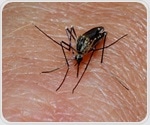| New consortium to build on breakthroughs in malaria research to develop P. vivax vaccines |
|
|
|
|
| |
|
| |
The latest malaria news from News Medical |
|
|
|
|
|
 | | |  Johns Hopkins researchers looking to develop a long-acting, injectable malaria preventive using atovaquone have shown in a new study that resistance may not be the challenge scientists thought it was, particularly when using atovaquone as a malaria preventive. Johns Hopkins researchers looking to develop a long-acting, injectable malaria preventive using atovaquone have shown in a new study that resistance may not be the challenge scientists thought it was, particularly when using atovaquone as a malaria preventive. | | | | |  Indiana University School of Medicine researchers have identified multiple species of bacteria that, when present in the gut, are linked to an increased risk of developing severe malaria in humans and mice. Indiana University School of Medicine researchers have identified multiple species of bacteria that, when present in the gut, are linked to an increased risk of developing severe malaria in humans and mice. | |
|
|
|
|
|